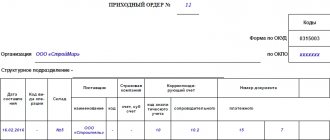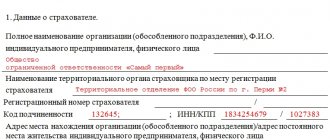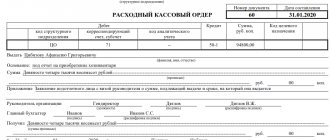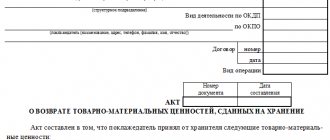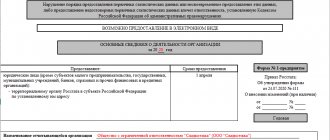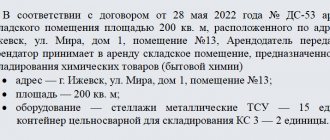How is a PKO issued?
The document is drawn up in a single copy. Corrections are not allowed when filling out. If suddenly the form is damaged, then you just need to fill it out again.
You can fill it out either by hand or using an accounting program on your computer. In addition, some sites allow you to create a cash receipt order online.
The main instructions for correctly filling out the PQS are prescribed in Bank of Russia Instructions No. 3210-U (as amended on June 19, 2017 No. 4416-U).
Please note that the form is divided by a tear line into two parts, both of which must be filled out at the same time.
On the left is the receipt document itself; this part remains in the budget organization. It is signed by the chief accountant and cashier.
On the right is the receipt. It is signed and certified by the seal of the budget organization, and then given to the person who deposits the cash.
PKO can be compiled:
- for each operation of accepting cash at the cash desk;
- for the entire amount of money received at the cash desk of a budget organization per day. Such a PKO is drawn up on the basis of a control tape removed from cash register equipment, strict reporting forms equivalent to a cash register receipt, and other documents provided for by Law No. 54-FZ dated May 22, 2003.
IMPORTANT!
The cash book is kept by the cashier (clause 4, clause 4.6, clause 4 of Directive No. 3210-U). The Central Bank allows any employee to fill out the book. When the amendments come into force, the director will be able to fill out the book, for example (clause 4 of Directive No. 3210-U).
PKO: sample filling
Similar articles
- Receipt for PKO (form and sample)
- Announcement for cash contribution (form and sample)
- Expense cash order: form and sample filling
- Receipt cash order
- Account cash warrant
Instructions for filling
You were able to study and download the cash receipt order (form) for free at the beginning of the article. Now let's figure out how to fill it out correctly.
Let's look at this procedure step by step.
Step 1. Fill out the header
We indicate the full name of the organization. If there is a cash desk in a structural unit, enter its name, and if not, put a dash.
The OKUD and OKPO codes assigned by the statistics agency are also indicated here.
Step 2. Fill out the “Debit” and “Credit” sections
The document number corresponds to the serial number in the registration journal (form No. KO-3) from the beginning of the calendar year. The date must coincide with the day the money is transferred.
The lines “Debit” and “Credit” are filled in according to the approved chart of accounts.
Step 3. We indicate who contributed the funds and why
In the “Accepted” line, enter your full name. the person from whom the cash was accepted.
In the line “Base” you need to clarify the business transaction. For example, payment for paid educational services.
Step 4. Enter the amount
The amount is indicated in words.
IMPORTANT!
Remember that the amount of cash payments under one agreement can be no more than 100,000 rubles. Accepting several PKOs for a total amount greater than the permitted amount will also be a violation!
The line “Including” indicates the amount of VAT, which is recorded in numbers, or the entry “Excluding tax (VAT)”.
Step 5. Fill out the receipt
The receipt for the PKO is filled out in the same way.
We only stamp the receipt. The left part of the PKO is issued without a seal.
Finally, we recommend checking the availability of supporting documents and whether the specified amount corresponds to the actual amount, and only then print the PQS.
Receipt cash order (form KO-1)
Home / Cash discipline
| Table of contents: 1. Procedure and methods for registering PQS 2. Instructions for filling out a receipt order 3. Sample of filling out RKO 4. Fines for the absence and storage periods of PKO | PKO in excel or word format Download samples of PKO: Founder’s contribution, Return of account, Compensation for damage, Money from the bank for salary, LLC loan from the founder, According to the contract from the legal entity. persons, Retail revenue from individual entrepreneurs, LLC trading revenue |
A receipt order is a unified form that is filled out upon receipt of cash at the cash desk of an organization (IP).
The company is obliged to issue a PKO in the following cases:
- Contribution of funds to the authorized capital;
- Return of unused amounts of accountable funds;
- Compensation for damage by an employee;
- Sale of property owned by the company;
- Return or receipt of borrowed funds;
- Receipt of money from the company account;
- Receipt of cash revenue from business activities (at the end of the working day, one PQR is filled in for the entire amount of revenue).
Individual entrepreneurs are not required to draw up PKO, as well as other cash discipline forms (for example: cash register, cash book, etc.), but can use such documents on their own initiative for the purpose of accounting and control over the movement and expenditure of cash.
Procedure and methods of registration of PKO
The unified order form (No. KO-1) was approved by Resolution of the State Statistics Committee of Russia dated August 18, 1998 No. 88.
The document consists of two parts: a cash receipt order and a receipt for the PKO.
The order is issued in one copy. Numbering is carried out in order in chronological sequence, the reference date is January 1 of each new year.
The person whose responsibilities include filling out the receipt order may be:
- an employee of the organization (cashier, accountant, etc.), appointed by order of the head of the company;
- Chief Accountant;
- manager (if the company does not have a chief accountant or accountant on staff).
The PKO is signed by: the chief accountant (accountant or director) and the cashier.
If the head of the organization (IP) single-handedly carries out cash transactions and draws up primary documentation, only the signature of the head (IP) is placed on the PKO.
The form is completed:
1) Manually.
2) On a computer with subsequent printing:
- in a text or spreadsheet editor;
- using specialized programs and online services.
3) In electronic form. With this method of document management, cash forms must be certified by a qualified electronic signature.
Corrections and blots when filling out the PQS are strictly not allowed!
The receipt for the order is filled out simultaneously with the PKO, signed and sealed.
To affix a seal impression the following can be used:
1) The main round seal of the organization.
It should be noted that since the entry into force of the law dated 04/06/2015 No. 82-FZ, organizations have the right to refuse to use a round seal.
2) Simple (auxiliary) seals and stamps kept by company employees responsible for their safety and use.
The seal impression should be located entirely on the receipt and not go onto the receipt order itself.
The cashier who receives the completed form from the accounting department is obliged to:
- check all order data;
- check the document for erasures and corrections;
- verify the authenticity of the signature of the chief accountant (or other responsible person);
- check the availability of the specified applications.
If all the rules are followed, the cashier accepts the money. The documents attached to the order should be stamped or handwritten: “Received” (“Paid”) with the date.
The executed PKO remains in the organization and is filed with the cashier’s report (the second copy of the cash book sheet), and the receipt is handed over to the person who deposited the cash.
Information about the order is entered into the order registration journal (No. KO-3). A record of received funds is reflected in the company's cash book.
Instructions: how to fill out a cash receipt order
The unified form is filled out as follows:
- In the “Organization” field, the full name of the company is indicated in accordance with the constituent documents.
- In the “according to OKPO” window, the corresponding code is indicated according to the Rosstat notification.
- The line “Structural division” is filled in if the company has divisions and only in situations where money is handed over by an employee of the representative office.
- Next, fill in the serial number of the form and the current date.
- The “Debit” and “Credit” cells indicate accounting account numbers or codes (if the company uses coding).
Individual entrepreneurs do not fill out these cells.
Transactions on the receipt of cash into the organization are reflected in the debit of account 50 (you should also indicate a subaccount in accordance with the company’s working chart of accounts).
For a loan, a corresponding account is recorded - the source of cash inflow, for example:
- 51 (52) – receipt of cash from the company’s bank account;
- 60 – the supplier returned the advance;
- 62 (76) – money received from customers and buyers;
- 66 (67) – borrowed funds received;
- 73-1 (2) – the employee compensated for material damage;
- 75-1 – the owner contributed a share to the authorized capital;
- 90-1 – revenue was received from the sale of products (services, works).
- “Structural unit code” is filled in if the unit for which the order is issued has a code.
- “Analytical accounting code” – enter the analytics code of the corresponding account (if such codes are provided in the organization).
- The amount of cash received in numerical terms is recorded in the “Amount” cell.
- The “Purpose Code” cell is filled in if the company uses a coding system.
- Full name is entered in the “Accepted from” line. company employee. When making payments between counterparties, the company name and full name are indicated. the employee who handed over the money, using the preposition “through”. For example: Meridian LLC through K.M. Ivanov.
- The content of the operation is entered in the “Base” line.
- In the “Amount” line, the amount of funds received is deciphered in words, with kopecks indicated in numbers.
- The “Including” line records the VAT rate and amount. If the transaction is not subject to VAT, it is indicated: “Without VAT”.
- The “Attachment” field lists the names, numbers and dates of the attached documents.
When filling out printed forms by hand, you should put dashes in the empty cells. Also, after entering the amount in words, be sure to cross out the empty space on the line to avoid falsification of the document.
The PKO receipt contains information identical to the data on the receipt order.
Sample of filling out a cash receipt order 2021
Contribution of the founder to the authorized capital
Return of accountable funds
Compensation for damage by the guilty party
Receiving money from the bank to pay salaries
LLC loan from the founder
Payment under an agreement from a legal entity
Retail revenue from individual entrepreneurs
LLC trading revenue
Penalties for the absence of PKO and storage periods for the form
For the lack of primary documents (gross violation of accounting rules), inspectors may fine the company under Art. 120 Tax Code of the Russian Federation:
- For 10,000 – 30,000 rubles;
- Or 20% of the unpaid amount if the tax base is understated, but not less than 40,000 rubles.
There are no sanctions for incorrect execution of the PKO, but a form filled out with errors can be equated to the absence of a document.
The absence of a PKO receipt from the counterparty may lead to the inspectors’ refusal to recognize expenses taken into account when calculating income tax (single tax under the simplified tax system). In such a situation, the counterparty will incur additional costs for paying taxes, fines and penalties.
The organization is obliged to store primary documentation, which includes the cash receipt order, for 5 years after the end of the reporting year.
Read in more detail: Form KO-1
Did you like the article? Share on social media networks:
- Related Posts
- Payroll register
- Cash accounting book (form KO-5)
- Sample of filling out form T-49
- Order on accountable persons
- Expense cash order (form KO-2)
- Cash payment limit in 2021
- Cash withdrawal from the cash register
- Payroll (form T-51)
Discussion: there is 1 comment
- Victor:
01/03/2020 at 08:31The PKO is filled out as follows: - organization (above) - one name (not related to the operation) - seal - another organization - There is no order itself - The receipt is filled out after the seal has been affixed (the handwriting of the second person) To whom should I appeal about the nullity of this document?
Answer
